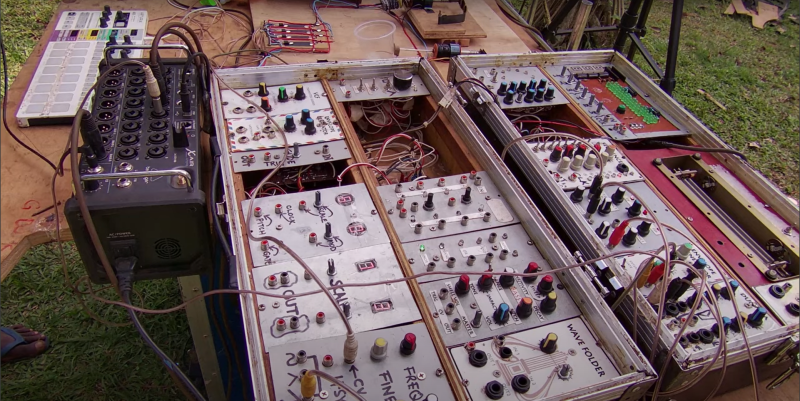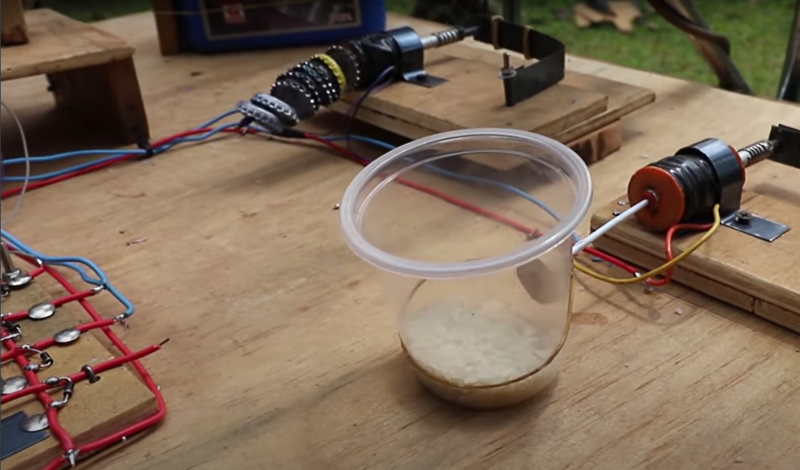South African [Afrorack] claims to have built the first home-built modular synthesiser in Africa. Whilst we can’t be sure of this (and to be frank, it doesn’t actually matter) what we can be sure of is that the latest additions to this rig sound pretty rad. (video, embedded below) There really isn’t much doubt that the African nations are the kings of rhythm, and that living in the less well-to-do areas you need to have a certain resourcefulness to use the materials around you. It’s not like you can just pop down to the local electronics store for a missing part, even if you had the funds for it.

The modular synth looks pretty nice, rough and ready like a real homebrew, and the use of an oil can as a bass drum and rice in a plastic skiff as an instrument might look crude, but sound pretty good. All three additions to the rig are simple spring-loaded solenoid affairs, but since off the shelf stuff is an expensive luxury, hand wound coils were in order. With a bobbin formed with a metal rod and two suitably trimmed fanta bottle lids, a wire spool holder sitting on what looks like a cake stand, a drill powered coil winder was constructed. We did smirk a little when in an early shot, wire was guided by hand, which was rapidly followed by an adjustment to guiding with a rag. Darn friction burns! We’re watching this with interest to see what the next additions will be, but for now, just sit back and nerd out to some sick African techno tunes!
Want to see a mess-o-wires turn into something meaningful? Got some Game Boys lying around needing something to do? How about a chiptune synth?
thanks [aaron] for the tip!















“Bamanya Brian is from Uganda, east Africa”.
So… not South Africa.
https://www.arturia.com/stories/brian-bamanya
Fair enough! In case you’re wondering, Ryan apparently looked at YouTube’s “about” page, where it says Brian is in South Africa. What the heck, YouTube?
Note also this isn’t the first time. I caught a post about Beijinger Handy Geng before it went out. YouTube says he’s in Hong Kong.
I’d call it an analogue ROMpler, as it stores the samples not in ROM but real world objects. So RWOmpler .)
Really cool video. I’m not sure how he got such clean audio from the shaker and snare/tambourine but the result is really nice.
Wow that’s hardcore.
Amazing what people can make.
Brilliant! Very creative!
I love electromechanical percussion! I had an electromechanical percussion setup about 20 years ago (with a simple DIY sequencer too) and the cost of all the solenoids pained me (as a broke student). Can’t believe I never though to hand-wind solenoids… such a good idea for something like this.
[Afrorack]’s synth doesn’t feel complete to me without an automated Kalimba (a.k.a. Mbira, African Thumb Harp, or Thumb Piano).[1] The Kalimba is perfectly suited for connection to a sequencer, to see why check out the short Kalimba YouTube demo/tutorial by [Kinobe] from Uganda in [2].
* References:
1. Mbira
https://en.wikipedia.org/wiki/Mbira
2. African Kalimba PLAYING TIPS and History
https://www.youtube.com/watch?v=woCwdAi3qcw
https://www.youtube.com/watch?v=woCwdAi3qcw
Brian is from Uganda